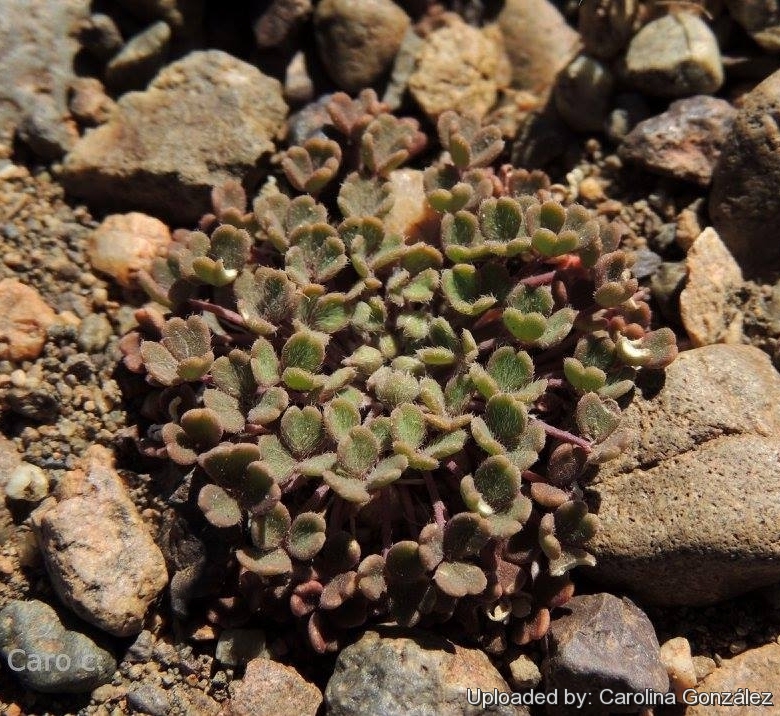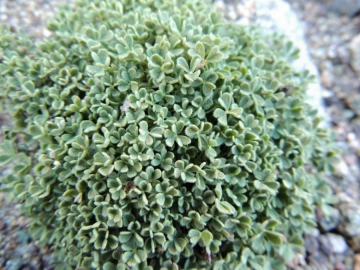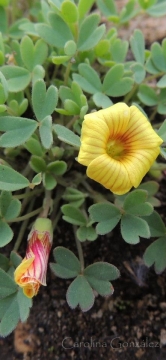
Oxalis compacta Photo by: Carolina González
Origin and Habitat: Oxalis compactaSN|30991]]SN|30991]] is widely distributed in the upper alpine belt in the Andes of central Chile (Bio-Bio, Coquimbo, Maule, O'Higgins, Santiago, Valparaiso Regions) and Argentina (Chubut, La Rioja, Mendoza, Neuquen, Rio Negro, San Juan, Santa Cruz provinces)
Altitude range: In its northern distribution area it grows to 4350 m.a.s.l. Southward in the Argentinian Andes the limit descends to around 1600 metres.
Habitat and ecology: The plants grow in dry steppes and semi-desert were they are quite difficult to spot as they are tiny and quite well camouflaged. They prefers rocky rather sandy soil. In these areas the drought may last 3 - 5 months and the precipitations (400-800 mm per annum) are concentrated in winter. It can be covered by snow for months (1 - 8 months). The main pollinators in the central Chilean Andes are high Andean butterflies (especially Yramea modesta, Phulia nymphula) and tiny bees of the genus Liphanthus (Andrenidae).
Synonyms:
See all synonyms of Oxalis compacta
back
Accepted name in llifle Database:Oxalis compacta Gillies ex Hook. & Arn.Bot. Misc. 3: 162 1832.Synonymy: 15
back
Description: Oxalis compactaSN|30991]]SN|30991]] is a perennial herb that forms small, more or less dense cushions, 1 to 5 cm high and 5-10 cm wide. Leaves are very numerous and forms a very dense foliage. It produces an attractive crop of yellow flowers.
Derivation of specific name: From Latin compactus, close together, condensed.
Stems: Very short, thick, branched,covered by the bases of the petioles.
Root: Thin fusiform ( non-bulbous).
Leaves: Clover-like, green, pink or purplish, each with 3 leaflets. Petiole to 5 cm long, glabrous or with few hairs. Leaflets sessile, obcordate, pubescent on both sides. Hairs white.
Flowers: Borne in reduced 1-flower cymes. Peduncles more or less short glabrous. Calyx sepals linear-oblong, obtuse, glabrous, ciliate on the margin. Petals yellow 4-5(-10) mm long, densely pubescent.
Bibliography: Major references and further lectures
1) ARROYO, M.T.K., R.B. PRIMACK & J.J. ARMESTO . 1982. “Community studies in pollination ecology in the high temperate Andes of central Chile I. Pollination mechanisms and altitudinal variation.” American Journal of Botany 69: 82-97.
2) DOMÍNGUEZ, D. 2010. "Detección de rasgos que compensarían la disminución altitudinal del servicio de polinización comunitaria en una especie heterostílica en la Cordillera de los Andes de Chile central." Masters Dissertation, Universidad de Chile, Chile. 70 pp.
3) MARY T. K. ARROYO, ANA MARÍA HUMAÑA, DANIELA DOMÍNGUEZ & GUS JESPERSEN “Incomplete trimorphic incompatibility expression in Oxalis compacta Gill. ex Hook. et Arn. subsp. compacta in the central Chilean Andes” Gayana Bot. 69(1): 88-99, 2012
4) Michail Belov. Encyclopedia of the Chilean Flora: Oxalis compacta http://www.chileflora.com Web. 04 April 2015.
5) William Jackson Hooker “Botanical miscellany. Vol.1-3. [afterw.] The Journal of botany. pt.1, vol.2-4 [afterw.] The London journal of botany. Vol.1-7 [afterw.] Hooker's journal of botany and Kew garden miscellany. Vol.1-9. [Ed.] by W.J. Hooker” 1833
 Oxalis compacta Photo by: Carolina González
Oxalis compacta Photo by: Carolina González - Flowering habit at Arroyo El Arco (Neuquen province, Argentina) Photo by: Carolina González
- Flowering habit at Arroyo El Arco (Neuquen province, Argentina) Photo by: Carolina GonzálezCultivation and Propagation: Oxalis is often overlooked as a garden flower because of its weed reputation. Oxalis compactaSN|30991]]SN|30991]] is not a weed, but a pretty and non-invasive, long-flowering Alpine specie adaptable to rock gardens, raised beds, pot culture, and window boxes. It is certainly a beautifully delicate plant that merits cultivation. This species is often grown by alpine enthusiasts because it likes a cool summer and is a good plant for rock gardens. Snow cover is probably necessary for protection in climates that have long and cold winters. As long as it gets enough sun and does not sit in water in winter, it blooms beautifully. Lots of light and good drainage are a must.
Soil: It should be potted in a mixture of peat, sand, pumice and lava grit, and loam and protected in a cold frame.
Water: Water and feed liberally only in spring till the plants bloom, but do not over water.
Exposure: Grow it in full sun. Plants usually do not live well where the sun is not strong, but those who live where the sun in stronger may tolerate some shade. If grown indoors put this pot plant in full sun to enjoy the flowers for a few weeks. Therefore, put it in the garden straight after flowering and enjoy it as a garden plant in the following year.
Hardiness: The plant tolerates low temperatures (-15° C even -20° C) but needs protection against winter rains, can tolerate snow cover for several weeks per year. USDA Hardiness Zone 7, even 6b. Snow cover is probably necessary for protection in climates that have long and cold winters.
Use: They make superb rock garden plants, as well as adequate for the front of a border as well as being perfect for pots and containers.
Pests and diseases: Prone to rust, slugs and snails.
Propagation: It may be propagated by offsets and by seeds. Sow them during autumn, in a mix of equal parts of compost, regular garden soil and sharp river sand. Cover this mix with a layer of sand, distribute the seeds and spread some more sand over them to barely cover the seeds. Place your sowing pan in a cold frame or cold greenhouse if you have heavy rain in your area. If you have snow, place the sowing pan outdoors and let nature do its work. The seedlings can be transplanted once they are 5 cm tall. These pretty plants can bloom the first year grown from seeds, but will display their best from the second year on.












